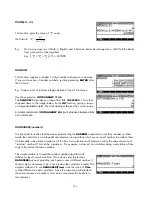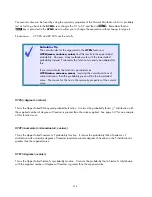
T
T
h
h
e
e
‘
‘
M
M
a
a
t
t
r
r
i
i
x
x
’
’
g
g
r
r
o
o
u
u
p
p
o
o
f
f
f
f
u
u
n
n
c
c
t
t
i
i
o
o
n
n
s
s
This group of functions is provided to deal with matrices.
The scope of functions & abilities covered in this group is in fact vastly greater than
would be required by the average high school student or teacher. In many cases
supplying an explanation in more detail than the manual of what the function is used for
would occupy many pages to no real useful gain. Consequently although some will
include detailed examples, some of the functions will be covered only very briefly.
Further examples are given in the chapter titled “Working with Matrices” on page 209.
COLNORM(<matrix>)
Finds the column norm of a matrix: the maximum, over all columns
contained in the matrix, of the absolute values of the sum of the elements
in each column.
⎡
1
2
3
⎤
Eg. For the matrix
M
1
=
⎢
⎢
4
5
6
⎥
⎥
, the column with the largest absolute sum of 13 is column 3.
⎢
−
1
5
4
⎥⎦
⎣
COND(<matrix>)
Finds the condition number, the 1-norm (column norm), of a square matrix.
CROSS([vector],[vector])
This function finds the cross product of two vectors. Vectors for this
function are written as single row matrices.
3
⎛ ⎞
4
For example,
a
=
(3, 4, 0) or
⎜ ⎟
would be written as
[3,4,0]
.
⎜ ⎟
⎜ ⎟
0
⎝ ⎠
Note: If you want to use the
Matrix Catalog
to define your matrices for
use with this function then you must use the
key to define them as
real vectors rather than as matrices as the
CROSS
function is one of the
few for which this matters.
195






























